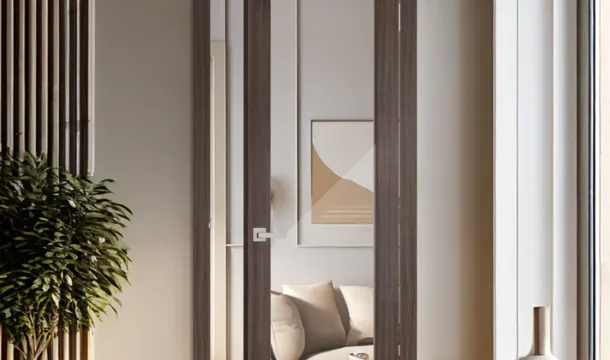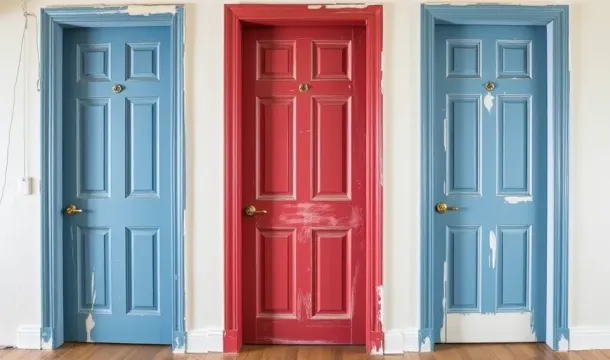How to Choose Pet-Friendly Interior Doors for Homes with Dogs and Cats
Popular Articles
When designing homes that accommodate pets, prioritizing safety and durability in all aspects is crucial. Opting for scratch-resistant materials in your interior barriers can significantly enhance the longevity of your living space while ensuring it remains a welcoming environment for both dogs and felines.
Consider options made from robust composites or solid wood, which withstand wear and tear caused by playful paws. These choices not only resist scratches but also maintain aesthetic appeal over time, making them ideal for pet owners who appreciate style without compromising functionality.
Incorporating features such as pet doors or low thresholds allows your four-legged companions easy access to different areas of the house, promoting their freedom while maintaining your home's layout. This thoughtful approach fosters a harmonious atmosphere where pets can explore safely without damaging interior spaces.
Ultimately, the right selection will create a comfortable haven for your furry family members while ensuring that your interior remains stylish and resilient against everyday challenges.
Materials That Resist Scratches
Selecting scratch-resistant materials is crucial for maintaining the integrity of your home when pets are present. Consider these durable options:
- Fiberglass: Known for its resilience, fiberglass can withstand claw marks and is often used in high-traffic areas.
- Steel: A strong choice, steel offers both durability and a sleek appearance. It is less likely to show damage from playful animals.
- Vinyl: This synthetic material provides a smooth surface that resists scratching. It's easy to clean and maintain, making it ideal for pet owners.
- Plywood with laminate finish: Plywood offers stability while laminate provides a protective layer against scratches. This combination helps keep surfaces looking new.
When selecting materials, prioritize those that not only resist damage but also complement the aesthetic of your living space. Pets can be rough on furnishings; therefore, investing in quality will pay off in the long run.
Regular maintenance can also enhance durability; consider touch-up paint or sealants to protect surfaces further. Choose wisely to create a harmonious environment for both pets and residents.
Designs for Easy Access
Opt for designs that feature lower thresholds or no threshold at all to facilitate seamless movement for your furry companions. These configurations minimize barriers, making it easier for pets to navigate throughout the house.
Arched tops on doors can enhance accessibility by allowing taller animals like dogs to pass comfortably without the risk of bumping their heads. This design also adds an aesthetic appeal that complements various home styles.
Consider cut-out shapes in doors, such as paw prints or bone outlines. These playful elements not only provide a visual charm but also serve as openings that allow smaller pets to enter and exit freely without needing to push against a solid surface.
Swinging doors are another excellent choice. They provide easy entry and exit for pets while remaining secure when closed. Look for models with mechanisms that prevent slamming, ensuring safety and comfort for both animals and humans.
Select sliding panels, which take up less space than traditional swinging options, allowing pets quick access while maintaining a sleek look. These can be particularly beneficial in tighter areas of the home.
When designing spaces, ensure there are multiple access points between rooms. This helps reduce congestion during busy times and allows dogs and felines to explore without restriction.
Colorful frames can also draw attention to designated pet entrances, encouraging use by your four-legged friends. Choose hues that complement your overall decor while signaling where pets are welcome to roam.
Soundproofing Options Available
For homes with pets, soundproofing can significantly enhance comfort. Consider solid core models, which provide superior noise reduction compared to hollow-core alternatives. These structures are often filled with dense materials that absorb sound waves effectively.
Acoustic panels can also be incorporated into door designs. These panels reduce noise transmission and can be installed on existing frames or as part of new installations, offering flexibility in decor.
Weatherstripping around edges creates a snug fit, minimizing gaps that allow sound to escape. This simple addition not only dampens noise but also improves energy efficiency.
Insulated doors made from composite materials offer another option. Their robust nature helps block sound while ensuring durability against scratches from playful paws.
Soundproofing seals, such as automatic door bottoms or sweep seals, help close the gap between the floor and the door, further enhancing sound insulation. This is especially useful in busy households where barking or meowing may disrupt peace.
Lastly, consider choosing doors with a heavy frame construction. The weight contributes to their ability to mitigate noise while maintaining safety for active animals within the home environment.
Height Considerations for Pets
Ensure the height of openings accommodates your furry friends. For smaller breeds and felines, a clearance of at least 8-10 inches from the floor is advisable. This allows easy passage without forcing them to jump or strain themselves.
Larger dogs may require a different approach; aim for a minimum height of 14-16 inches to prevent any inconvenience. This consideration not only promotes comfort but also enhances safety by reducing the risk of injuries during movement.
When selecting products, consider adjustable models that can adapt as your pets grow or if you decide to bring in new additions. A well-planned height can enhance mobility and create a harmonious living environment in your household.
Finally, keep in mind that some breeds have unique characteristics, such as longer bodies or larger frames. Ensuring adequate space helps foster their natural behavior and keeps them happy within the confines of your residence.
Safety Features to Include
Incorporating safety features into your home is essential for the well-being of your furry companions. Opt for doors with rounded edges to prevent injuries during play or movement. Magnetic closures can also enhance safety by ensuring that pets cannot accidentally push open a door, keeping them secure in designated areas.
Consider installing doors made from non-toxic materials, as pets are known to chew and scratch surfaces. Look for options that have been treated to resist splintering, which can pose choking hazards. Additionally, including tempered glass panels allows visibility while maintaining durability against scratches and impacts.
Another vital feature is the inclusion of ventilation holes or screens. This promotes airflow while providing an escape route in case of emergencies, allowing pets to exit safely if needed. Ensure that these openings are adequately sized to prevent entrapment but not large enough for small animals to squeeze through.
Lastly, consider integrating automatic closing mechanisms. These help keep doors securely shut without requiring manual effort, reducing the risk of accidental escapes and ensuring a safe environment for both dogs and felines at home.
Popular Articles

Choosing the Perfect Interior Doors for Your Canadian Home

A Complete Guide to Choosing Interior Doors for Canadian Homes
